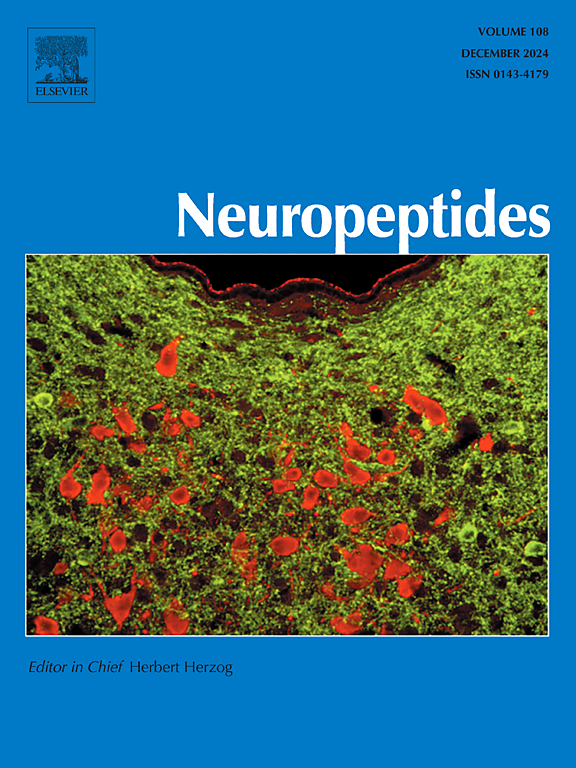Netrin-3 enhances recovery and reduces inflammation following spinal cord injury via suppressing NLRP1 inflammasome activation
IF 2.7
3区 医学
Q3 ENDOCRINOLOGY & METABOLISM
引用次数: 0
Abstract
Spinal cord injury (SCI) represents a significant challenge in the field of neurology due to its complex pathology and the limited efficacy of current treatments. The search for effective therapeutic strategies has led to investigations into molecules that can promote neural repair and functional recovery. Netrin-3, previously known for its roles in axonal guidance and development, emerges as a potential candidate for enhancing recovery post-SCI. Hereby, we used gene therapy to increase Netrin-3 expression in SCI mouse models and evaluated neurological recovery through behavioral tests, histological assessments, and biochemical analyses. Additionally, we examined the activation of the NOD-like receptor family pyrin domain containing 1 (NLRP1) inflammasome and production of interleukin-1β (IL-1β) and IL-18, and confirmed the dependency of Netrin-3's neuroprotective effects on the Adenosine Monophosphate-activated Protein Kinase (AMPK) pathway using an AMPK inhibitor. Our results explores the impact of Netrin-3 on neurological recovery following SCI. It was observed that Netrin-3 expression markedly decreased at both mRNA and protein levels after injury. Enhancing Netrin-3 levels through gene therapy improved neurological outcomes, including locomotor function, reduced lesion size, and normalized spinal cord water content compared to untreated injured mice. Furthermore, Netrin-3 administration mitigated oxidative stress by modulating malondialdehyde (MDA) levels and superoxide dismutase (SOD) activity, and inhibited NLRP1 inflammasome activation, resulting in suppressed IL-1β and IL-18 production. The AMPK pathway was activated by Netrin-3 post-injury, suggesting a mechanism underlying its neuroprotective effects. However, these beneficial impacts were abolished by an AMPK inhibitor, indicating the dependency of Netrin-3's protective actions on the AMPK pathway. Collectively, these findings highlight Netrin-3 as a promising target for developing novel therapies aimed at improving restoration from SCI.
Netrin-3通过抑制NLRP1炎性体的激活来促进脊髓损伤后的恢复和减少炎症
脊髓损伤(SCI)由于其复杂的病理和目前治疗效果有限,是神经病学领域的一个重大挑战。对有效治疗策略的探索导致了对能够促进神经修复和功能恢复的分子的研究。Netrin-3,先前以其在轴突引导和发育中的作用而闻名,成为增强脊髓损伤后恢复的潜在候选者。因此,我们采用基因治疗增加脊髓损伤小鼠模型中Netrin-3的表达,并通过行为测试、组织学评估和生化分析评估神经恢复情况。此外,我们检测了含有1 (NLRP1)炎症小体的nod样受体家族pyrin结构域的激活和白介素-1β (IL-1β)和IL-18的产生,并使用AMPK抑制剂证实了Netrin-3的神经保护作用依赖于腺苷单磷酸活化蛋白激酶(AMPK)途径。我们的研究结果探讨了Netrin-3对脊髓损伤后神经恢复的影响。观察到Netrin-3在损伤后mRNA和蛋白水平均显著降低。与未治疗的损伤小鼠相比,通过基因治疗提高Netrin-3水平改善了神经系统预后,包括运动功能、病变大小缩小和脊髓含水量正常化。此外,Netrin-3通过调节丙二醛(MDA)水平和超氧化物歧化酶(SOD)活性,抑制NLRP1炎性体活化,从而抑制IL-1β和IL-18的产生,从而减轻氧化应激。损伤后AMPK通路被Netrin-3激活,提示其神经保护作用的机制。然而,这些有益的影响被AMPK抑制剂所消除,这表明Netrin-3的保护作用依赖于AMPK途径。总的来说,这些发现突出了Netrin-3作为开发旨在改善脊髓损伤恢复的新疗法的有希望的靶点。
本文章由计算机程序翻译,如有差异,请以英文原文为准。
求助全文
约1分钟内获得全文
求助全文
来源期刊

Neuropeptides
医学-内分泌学与代谢
CiteScore
5.40
自引率
6.90%
发文量
55
审稿时长
>12 weeks
期刊介绍:
The aim of Neuropeptides is the rapid publication of original research and review articles, dealing with the structure, distribution, actions and functions of peptides in the central and peripheral nervous systems. The explosion of research activity in this field has led to the identification of numerous naturally occurring endogenous peptides which act as neurotransmitters, neuromodulators, or trophic factors, to mediate nervous system functions. Increasing numbers of non-peptide ligands of neuropeptide receptors have been developed, which act as agonists or antagonists in peptidergic systems.
The journal provides a unique opportunity of integrating the many disciplines involved in all neuropeptide research. The journal publishes articles on all aspects of the neuropeptide field, with particular emphasis on gene regulation of peptide expression, peptide receptor subtypes, transgenic and knockout mice with mutations in genes for neuropeptides and peptide receptors, neuroanatomy, physiology, behaviour, neurotrophic factors, preclinical drug evaluation, clinical studies, and clinical trials.
 求助内容:
求助内容: 应助结果提醒方式:
应助结果提醒方式:


